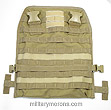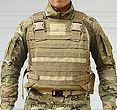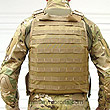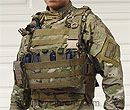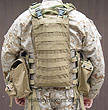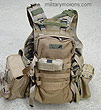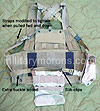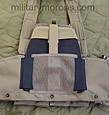2nd Line Gear page 1 page 2 page 3 page 4
TO VIEW FULL SIZE IMAGES: USERNAME and PASSWORD are both "mm"
| 2/19/06 - New from SOTECH (Special Operations Technology) is their BLoCS (Battle Load Carry System) Front/Rear/Side Plate Carrier (product code: BFRPC). Designed as a high-mobility armoured system, the BRFPC will take soft-armour inserts and front/side/rear plates. The designer of this rig and I were joking about the need for a more memorable name for some of SOTECH's rigs (like the "Hellcat"), and dubbed this the 'MACE' (Modular Armoured Carrying Equipment) rig, as a interim nickname. Even though it's not an official SOTECH designation and they probably won't know what you're referring to if you call, I'll refer to it as the MACE rig as it's easier to remember than 'BRFPC'. The MACE rig simply consists of a front and rear carrier. The front carrier shown here is plate-shaped; meaning it has to be used with a stand-alone plate or an in-conjunction plate with plate-shaped soft insert behind it. SOTECH makes different carriers to accomodate soft panels with 'wings', as well, and is working on having panels made specifically for the MACE. Contact SOTECH for more details on whether your panels will fit. As far as I know, there is no plan to accomodate BALCS cut panels. The carrier is sized according to plate size. I was able to utilize a civvie concealed-armour panel in this front carrier, that was only a bit larger than a SAPI plate. The front carrier has two 2" female buckles in the front to which the shoulder straps connect. The front carrier connects to the rear panel on the sides by a strap that goes across the front of the carrier. It can be moved up or down to three different positions between the PALS webbing. Velcro on the rear of the carrier interfaces with the rear carrier wings/cummerbund. The front carrier has a plate pocket, and behind that, a mesh soft-insert compartment. There is a quick-ditch plate feature - a strap goes over the plate and is connected to an ambidextrous pull tab which velcros on the inside flap of the carrier. To ditch a plate, one of both of the T-handles on the end of the tab are pulled, which opens the flap and pulls the plate out. A velcro PALS patch is located in the center of the upper chest for placement of pouches or a velcro patch. The rear carrier accomodates a plate and soft insert with wrap-around wings. The rear carrier has wings that wrap around to the front, where the two ends overlap (depending on your girth). The wings are normally secured inside the front carrier, but can also wrap around the outside for attachment one of the SOTECH chest harnesses. The 2" wide shoulder straps are sewn to the top of the rear carrier, and are velcro-adjustable for length. The removable shoulder pads are shown installed. The inside of the carrier is the mesh compartment for the soft armour insert. The rear carrier shares the same plate quick-ditch system as the front, utilizing the T-handles. A rear drag handle sewn to the top of the carrier velcroes out of the way when not in use. The front and rear carriers connect on the sides by buckles, which are moved to different PALS columns for adjustment. Only one buckle per side is needed, but I illustrated both types here. One looks like a straight 'T', and is inserted into any column of PALS at any height. It can be loosened then cinched up with a tug. The other one which looks like a 'T' with the buckle at a 90° angle mounts on the bottom row of PALS. This is for securing the front and rear carriers at the bottom only and is adjusted by placing it back and forth along the bottom row of PALS. On each side of the cummerbund is a side-plate pocket to accomodate a 6"x9" side plate. In the pics below, a size large MACE is shown with both side-securing buckles installed, large SAPI plates and civvie Level IIIA soft inserts. I later moved the upper side straps to the row above the location in the pics to get them out of the way of the side pouches. The rig is donned by slipping it over your head, bringing the rear wings around to the front, then allowing the velcro on the inside of the front carrier to inteface with the wings. It makes it easier if the wings overlap in front, but it's not absolutely necessary. It might take a couple of times to get the front carrier lined up at the right height and centered. The side straps are buckled and cinched tight, and if installed, the bottom side buckles are closed. Doffing the rig is easiest by releasing the side buckles and shoulder strap on one side. Shown below is the MACE with some BLoCS pouches attached. Many of
the Gen II BloCS pouches are made from 500d Cordura, instead of 1000d.
According to SOTECH, this results in about a 40% weight savings and
only 10% reduction in durability. Upper center of chest: double pistol
mag pouch with elastic retention (code BDPSPME). Each pouch will take
single-stack or double stack pistol mags. Front lower right: Double
pouch double mag flapped (code BDPDM14). This holds 4 M4 or 2 M14
mags. Non-removable flap and elastic retention. Front lower left:
two Single pouch triple mag (code BSPTMFM4). Each pouch holds 3 M4
mags. Under the right arm (on wing): tool/mag/light/grenade pouch
(code BTMLGP). Holds two .45 single stack mags or one double stack
pistol mag, chem lights, multi-tool or 40mm grenade. Under the left
arm is the small zippered medical pouch (code BSZMP). |
|
The Weesatch is made up of a front and rear panel. The front
panel, shown immediately below, has 6 internal compartments, sandwiched
between the outer torso (or cummerbund) panel and the inner panel.
They're divided by 2" webbing, and the center 4 compartments
will hold 2 M4 mags each, or one AK or FAL mag. The compartments
at each end are triangular instead of rectangular in cross-section,
as the sides are where the front and rear torso panels are sewn
together. They'll hold one mag each, of the 3 types mentioned
above, but because the panels wrap around the torso, anything
put in the end compartments will be tightly held. So, it's possible
to add an additional magazine at each end, but they won't be the
easiest to draw (especially a curved AK mag), which is why I limited
the practical capacity to 4 AK and FAL mags. Since FAL mags are
shorter, a foam spacer block can be put at the bottom of the compartments
so the bottom of the mag sticks out, or else it might prove difficult
to remove. Each compartment is lined with loop velcro on the front
and back for attachment of the magazine retaining straps, which
are adjustable. The rear panel of the Weesatch can carry a rear plate, and a large hydration bladder. The plate pocket is raised - the plate sits high in the panel, providing the proper coverage in the back. At each of the top corners is a 2" triglide, for attaching the shoulder straps to, which connect the rear to the front. Between them is a drag handle. A 2" wide waist belt is passed through either an upper or lower slot at the bottom back, depending on torso length. It has 2" male buckles which connect to the females on each end of the cummerbund in front. 6 rows and 7 channels of PALS webbing on the back provide space for mounting of additional pouches. Also available are some accessories specifically for the Wasatch and Weesatch, which are shown installed on the Weesatch in these photos.
In the pics below, the Weesatch is shown worn over the BCS soft armour carrier, since the front plate I had in there wasn't stand-alone . The only additional pouches are 3 pistol mag pouches. I'm also wearing HSGI's excellent MultiCam tactical cap, which has velcro for the attachment of patches, and an elastic back strap which keep the cap secure on my noggin (I wore it hiking up in the mountains in high wind, that blew off other caps). I wore the Weesatch at the range in an informal class for about
6 hours, with 8 M4 mags 3 pistol mags, and a full hydration bladder,
with and without plates (I took them out to see how it felt for
just carrying equipment). I wasn't wearing any soft armour underneath,
and I appreciated the accessory shoulder pads. Because the front
is connected to the back at the sides, and there are no cross
straps in the back that connect to the front, having the weight
properly distributed is important to prevent the front slipping
down or vice versa. Keep the side straps tight, counter weight
the ammo in front with a hydration bladder, or put both plates
in, and it stayed pretty stable. That being said, I'd recommend
using the Weesatch with plates, the way it was designed, instead
of as a 'stand-alone' chest rig if you're not going to have any
weight in the rear. All in all, it's a slick, relatively light (because of the internal compartments) and well built rig - just what I'd expect from High Speed Gear. |
| PRACTICAL TACTICAL/HSGI PT-03 MESA VEST (discontinued)
My inital impression is based on a brand new item, not yet broken in. I will update this in the near future when I carry a load and wear it for a while. Update (4/09/04) - The mesh does break in after use and becomes more conforming. The issues with the shoulder geometry doesn't change, and I'm sure that it won't bother some people. I've made a few suggestions to Gene and Tim on what I'd like seen changed on the vest, but it's based on my personal preference, and whether they'll implement the suggestions will be based on cost, practicality, and feedback from the majority of users (not just mine).
|
Shown below is the MESA loaded up with 2 BH STRIKE M4 mag pouches, pistol pouches and SAW pouch, 70 oz camelbak bladder (it'll hold a 100 oz), strobe pouch, custom Reccegear pouch. On the extreme right are pics of the Kifaru E&E pouch docked and locked to the MESA.
L.E.O MODULAR SWAT ENTRY VEST
 |
This vest (model
L.E.O Modular) was made for a Federal agency by Tactical Solutions International
(T.S.I.), no longer in business. The entire vest shell is made of 1000
denier Dupont Cordura Nylon Plus, treated with urethane. It is covered
with a grid of snaps and velcro, and will take modular pouches from
Point Blank, PACA, Safariland etc. The pouches shown were made by T.S.I.
and are also of the same material as the shell, and quite sturdy. This
style is popularized by LAPD SWAT and other police SWAT teams. The modular nature of the vest allows the user to tailor the pouch/pocket arrangement to suit the mission. The pouch arrangement will hold 5 MP5 magazines and 8 pistol magazines. It is of the side-entry type, and after putting it over your body, you then wrap the back 'cumberbund' around your waist which secures the back panel flush against your back. The front panel is then pressed down onto the front of the 'cumberbund' and smoothed out, pressing back. The side flaps attached to the back panel then fold over the front flaps, making the vest very secure. It will accomodate most ballistic inserts from most concealment vests (full coverage). I put level IIIA spectra ballistic inserts from Armor Technologies Corp in it. There is a front trauma plate pocket and a larger map pocket that will also accomodate a small ceramic plate. It's a very comfortable vest, and has a lot of adjustment in height and girth. It is not as bulky as I thought it would be and its low profile doesn't hamper mobility and movement. See the Uniforms page for more pics. |
|
|
ATTENTION! PLEASE DO NOT LINK
DIRECTLY TO MY IMAGES -
IT RESULTS IN MY BANDWIDTH ALLOCATIONS BEING EXCEEDED,
AND MY PAGES GO DOWN. THANKS!
/ . PLEASE OBSERVE AND RESPECT
OUR COPYRIGHT! . /
©opyright by MilitaryMorons.com. All Rights Reserved. Reproduction, Duplication,
Distribution Strictly Prohibited.
Unless mentioned otherwise, content and images are the property of militarymorons.com
and are not in the public domain.
They are not to be used without
permission. Please Contact
me for permission to use any images or content herein.
